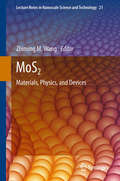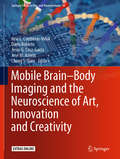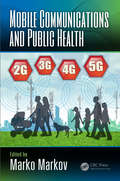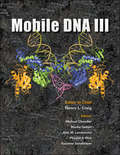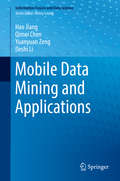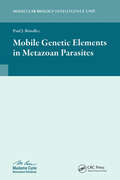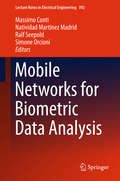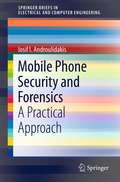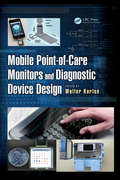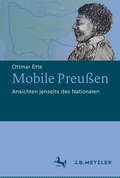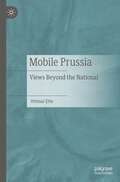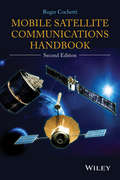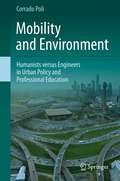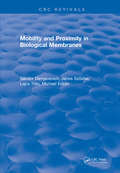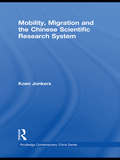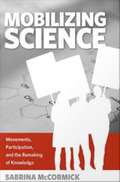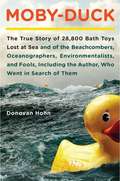- Table View
- List View
Mixtures and Solutions
by Lawrence Hall of Science University of California at BerkeleyNIMAC-sourced textbook
Mixtures and Solutions
by Lawrence Hall of Science University of California at BerkeleyNIMAC-sourced textbook
Mixtures and Solutions: FOSS Science Stories
by University of California at Berkeley Lawrence Hall of ScienceNIMAC-sourced textbook
Miénteme... si te atreves: Claves para detectar la mentira y potenciar tu credibilidad
by José Luis Martín Ovejero«Yo no he sido», «no pasa nada», «te lo juro»... Los humanos mentimos y con frecuencia. En este libro, el experto en comunicación no verbal JOSÉ LUIS MARTÍN OVEJEROte da las claves para que la próxima vez que lo intenten puedas estar alerta. ¿Quieres descubrir las las señales de la mentira? No te dejes engañar. ¡Vive con ventaja! Cuando las personas mienten o no confían en lo que cuentan, se comunican de manera diferente y tanto su lenguaje como su cuerpo pueden delatarlas. Lo mejor de todo es que no son conscientes, no lo pueden evitar. Sin la preparación adecuada, nuestra capacidad de detectar la falta de honestidad es puro azar. Conocer los indicadores concretos de engaño y la detección de la mentira es fundamental a la hora de elevar los índices de éxito en esta misión. Y el propósito de este libro es que puedas identificarlos. No importa tu profesión, saber cuándo alguien miente puede resultarte de gran utilidad en todas las facetas de tu vida. Los lectores han dicho de Tú habla, que yo te leo:«Con ilustraciones, imágenes de personajes relevantes de distintos ámbitos y escrito de una manera conversacional, parece que estás asistiendo a una de sus clases y que te lo está explicando solo a ti». «Definitivamente, José Luis Martín Ovejero ha creado un gran libro que consigue engancharte desde el principio». «Un libro magnífico pero, sobre todo, una herramienta perfecta para dejar de caminar "a ciegas" en la vida. Me dedico a los RRHH y a la comunicación, por lo que este libro se convierte, para mí, en un auténtico tesoro». «Un imprescindible para leer lo que los demás no te dicen con palabras».
MoS2
by Zhiming M. WangThis book reviews the structure and electronic, magnetic, and other properties of various MoS2 (Molybdenum disulfide) nanostructures, with coverage of synthesis, Valley polarization, spin physics, and other topics. MoS2 is an important, graphene-like layered nano-material that substantially extends the range of possible nanostructures and devices for nanofabrication. These materials have been widely researched in recent years, and have become an attractive topic for applications such as catalytic materials and devices based on field-effect transistors (FETs) and semiconductors. Chapters from leading scientists worldwide create a bridge between MoS2 nanomaterials and fundamental physics in order to stimulate readers' interest in the potential of these novel materials for device applications. Since MoS2 nanostructures are expected to be increasingly important for future developments in energy and other electronic device applications, this book can be recommended for Physics and Materials Science and Engineering departments and as reference for researchers in the field.
Mobile Brain-Body Imaging and the Neuroscience of Art, Innovation and Creativity (Springer Series on Bio- and Neurosystems #10)
by Jose L. Contreras-Vidal Chang S. Nam Dario Robleto Jesus G. Cruz-Garza José M. AzorínMobile Brain–Body Imaging and the Neuroscience of Art, Innovation and Creativity is a trans-disciplinary, collective, multimedia collaboration that critically uncovers the challenges and opportunities for transformational and innovative research and performance at the nexus of art, science and engineering. This book addresses a set of universal and timeless questions with a profound impact on the human condition: How do the creative arts and aesthetic experiences engage the brain and mind and promote innovation?How do arts–science collaborations employ aesthetics as a means of problem-solving and thereby create meaning?How can the creative arts and neuroscience advance understanding of individuality and social cognition, improve health and promote life-long learning?How are neurotechnologies changing science and artistic expression?How are the arts and citizen science innovating neuroscience studies, informal learning and outreach in the public sphere?Emerging from the 2016 and 2017 International Conferences on Mobile Brain–Body Imaging and the Neuroscience of Art, Innovation and Creativity held in Cancun, Mexico and Valencia, Spain to explore these topics, this book intertwines disciplines and investigates not only their individual products—art and data—but also something more substantive and unique; the international pool of contributors reveals something larger about humanity by revealing the state of the art in collaboration between arts and sciences and providing an investigational roadmap projected from recent advances.Mobile Brain–Body Imaging and the Neuroscience of Art, Innovation and Creativity is written for academic researchers, professionals working in industrial and clinical centers, independent researchers and artists from the performing arts, and other readers interested in understanding emergent innovations at the nexus of art, science, engineering, medicine and the humanities. The book contains language, design features (illustrations, diagrams) to develop a conversational bridge between the disciplines involved supplemented by access to video, artistic presentations and the results of a hackathon from the MoBI conferences.
Mobile Communications and Public Health
by Marko S. MarkovThis book represents a comprehensive overview of the distribution of the various forms of mobile communications devices, with increasing variations and intensities that constitute a serious hazard to both the biosphere and mankind. Contributors stress the lack of controls over mobile communication signal sources, as well as the absence of monitoring the health of individuals exposed to microwave radiation. The work also entails a review of the engineering behind mobile communication technology, including a summary of basic scientific evidence of the effects of biological exposure to microwaves, and unique coverage on potential hazards of mobile communication for children. Marko S. Markov has been professor and chairman of the Department of Biophysics and Radiobiology of Sofi University for 22 years. With over 45 years of basic science research experience, and over 40 years in the clinical application of electromagnetic fields, he is recognized as one of the world’s best experts in the subject. His list of publications includes 196 papers and 18 books. Presents an overview of what modern science knows about mobile communications signals Details the latest research on potential hazards related to uncontrolled use of mobile devices Provides information related to children's organisms not developed biologically prior to exposure to microwave signals Offers methods of control of the house and work environment Explores the link between science and electromagnetics hazards.
Mobile DNA III (ASM Books #45)
by Nancy L. CraigAn exploration of the raw power of genetic material to refashion itself to any purpose… Virtually all organisms contain multiple mobile DNAs that can move from place to place, and in some organisms, mobile DNA elements make up a significant portion of the genome. Mobile DNA III provides a comprehensive review of recent research, including findings suggesting the important role that mobile elements play in genome evolution and stability. Editor-in-Chief Nancy L. Craig assembled a team of multidisciplinary experts to develop this cutting-edge resource that covers the specific molecular mechanisms involved in recombination, including a detailed structural analysis of the enzymes responsible presents a detailed account of the many different recombination systems that can rearrange genomes examines the tremendous impact of mobile DNA in virtually all organisms Mobile DNA III is valuable as an in-depth supplemental reading for upper level life sciences students and as a reference for investigators exploring new biological systems. Biomedical researchers will find documentation of recent advances in understanding immune-antigen conflict between host and pathogen. It introduces biotechnicians to amazing tools for in vivo control of designer DNAs. It allows specialists to pick and choose advanced reviews of specific elements and to be drawn in by unexpected parallels and contrasts among the elements in diverse organisms. Mobile DNA III provides the most lucid reviews of these complex topics available anywhere.
Mobile Data Mining and Applications (Information Fusion and Data Science)
by Hao Jiang Qimei Chen Yuanyuan Zeng Deshi LiThis book focuses on mobile data and its applications in the wireless networks of the future. Several topics form the basis of discussion, from a mobile data mining platform for collecting mobile data, to mobile data processing, and mobile feature discovery. Usage of mobile data mining is addressed in the context of three applications: wireless communication optimization, applications of mobile data mining on the cellular networks of the future, and how mobile data shapes future cities. In the discussion of wireless communication optimization, both licensed and unlicensed spectra are exploited. Advanced topics include mobile offloading, resource sharing, user association, network selection and network coexistence. Mathematical tools, such as traditional convexappl/non-convex, stochastic processing and game theory are used to find objective solutions. Discussion of the applications of mobile data mining to cellular networks of the future includes topics such as green communication networks, 5G networks, and studies of the problems of cell zooming, power control, sleep/wake, and energy saving. The discussion of mobile data mining in the context of smart cities of the future covers applications in urban planning and environmental monitoring: the technologies of deep learning, neural networks, complex networks, and network embedded data mining. Mobile Data Mining and Applications will be of interest to wireless operators, companies, governments as well as interested end users.
Mobile Genetic Elements in Metazoan Parasites
by Paul J. BrindleySubstantial proportions of the genome of most eukaryotes, including those of metazoan parasites, are comprised of repetitive sequences. Mobile genetic elements (MGEs) constitute much of the repetitive component, particularly the interspersed sequences. This volume of nine chapters addresses MGEs that have colonized the genomes of medically important metazoan parasites and their vectors. These MGEs are parasites of parasites. These mobile elements are compared and contrasted with those from better-studied model organisms. The authors have included plentiful, relevant, and informative illustrations and references.Several chapters focus on mobile elements of the human schistosomes. Gerardo Ferbeyre focuses on the putative ribozyme activities on the SM alpha elements, SINE-like elements, including trans reactions catalyzed by these retroposons. Ricardo DeMarco and Sergio Verjovski-Almeida review the cut-and-paste transposons of schistosomes, including the Merlin and the SmTRC1 elements, and application of schistosome DNA transposons to transgenesis and mutagenesis. Claudia Copeland, Thewarach Laha and I review the retrovirus-like retrotransposons and non-long terminal repeat transposable elements of the schistosomes, including the Boudicca, fugitive and SR2 elements. Young-An Bae and Yoon Kong provide descriptions of retrotransposons from the human liver and lung flukes, Clonorchis sinensis and Paragonimus westermani, respectively, including the CsRn1 long terminal repeat retrotransposon. Continuing the investigations of MGEs of parasitic worms, Thewarach Laha, Alex Loukas and I summarize current knowledge of MGEs from hookworms, including details of the bandit and Transib transposons and dingo retrotransposons.Mobile elements in vectors of human parasites are also covered. Matty Knight and coauthors describe the nimbus retrotransposon and its discovery and other repetitive elements from the genome of the gastropod snail Biomphalaria glabrata, the intermediate host of Schistosoma mansoni. Zhijian Tu and Song Ti review MGEs of Anopheles mosquitoes, vectors of malaria, and other mosquitoes. They discuss practical uses of these MGEs. Craig Coates provides an expert article on transposon mediated transgenesis of mosquitoes, in particular dealing with his pioneering studies on the deployment of binary systems with the Mos1 mariner transposon.MGEs from the genomes of these metazoan parasites have practical uses in transgenesis and epidemiological studies and also are valuable for annotation of the genomes of these vectors and pathogens. These issues and future directions are well covered in these chapters.
Mobile Networks for Biometric Data Analysis
by Simone Orcioni Natividad Martínez Madrid Massimo Conti Ralf SeepoldThis book showcases new and innovative approaches to biometric data capture and analysis, focusing especially on those that are characterized by non-intrusiveness, reliable prediction algorithms, and high user acceptance. It comprises the peer-reviewed papers from the international workshop on the subject that was held in Ancona, Italy, in October 2014 and featured sessions on ICT for health care, biometric data in automotive and home applications, embedded systems for biometric data analysis, biometric data analysis: EMG and ECG, and ICT for gait analysis. The background to the book is the challenge posed by the prevention and treatment of common, widespread chronic diseases in modern, aging societies. Capture of biometric data is a cornerstone for any analysis and treatment strategy. The latest advances in sensor technology allow accurate data measurement in a non-intrusive way, and in many cases it is necessary to provide online monitoring and real-time data capturing to support a patient's prevention plans or to allow medical professionals to access the patient's current status. This book will be of value to all with an interest in this expanding field.
Mobile Phone Security and Forensics
by I. I. AndroulidakisMobile Phone Security and Forensics provides both theoretical and practical background of security and forensics for mobile phones. The author discusses confidentiality, integrity, and availability threats in mobile telephones to provide background for the rest of the book. Security and secrets of mobile phones are discussed including software and hardware interception, fraud and other malicious techniques used "against" users. The purpose of this book is to raise user awareness in regards to security and privacy threats present in the use of mobile phones while readers will also learn where forensics data reside in the mobile phone and the network and how to conduct a relevant analysis.
Mobile Point-of-Care Monitors and Diagnostic Device Design (Devices, Circuits, and Systems #31)
by Walter Karlen, Krzysztof IniewskiEfficient mobile systems that allow for vital sign monitoring and disease diagnosis at the point of care can help combat issues such as rising healthcare costs, treatment delays in remote and resource-poor areas, and the global shortage of skilled medical personnel. Covering everything from sensors, systems, and software to integration, usability, and regulatory challenges, Mobile Point-of-Care Monitors and Diagnostic Device Design offers valuable insight into state-of-the-art technologies, research, and methods for designing personal diagnostic and ambulatory healthcare devices. Presenting the combined expertise of contributors from various fields, this multidisciplinary text: Gives an overview of the latest mobile health and point-of-care technologies Discusses portable diagnostics devices and sensors, including mobile-phone-based health systems Explores lab-on-chip systems as well as energy-efficient solutions for mobile point-of-care monitors Addresses computer vision and signal processing for real-time diagnostics Considers interface design for lay healthcare providers and home users Mobile Point-of-Care Monitors and Diagnostic Device Design provides important background information about the design process of mobile health and point-of-care devices, using practical examples to illustrate key aspects related to instrumentation, information processing, and implementation.
Mobile Positioning and Tracking
by Simone Frattasi João FigueirasThis book presents the most recent state of the art in mobile positioning and tracking techniques.This book discusses mobile positioning solutions applied on top of current wireless communication networks. In addition, the authors introduce advanced and novel topics such as localization in heterogeneous and cooperative networks, providing a unified treatment of the topic for researchers and industry professionals alike. Furthermore, the book focuses on application areas of positioning, basics of wireless communications for positioning, data fusion and filtering techniques, fundamentals of tracking, error mitigation techniques, positioning systems and technologies, and cooperative mobile positioning systems.Key Features:Covers the state of the art of satellite- and terrestrial-based positioning systems, spanning from outdoor to indoor environments and from wide area networks to short-range networksDiscusses a whole range of topics related to mobile positioning: from fundamentals of positioning to the description of a wide spectrum of mobility models for tracking, from details on data fusion and filtering techniques to error mitigation techniques (including aspects of signal processing)Provides a solid bridge between research and industry envisaging a potential implementation of the presented solutionsFills the gap between positioning and communication systems, showing how features of communication systems can be used for positioning purposes and how the retrieved location information can be used to enhance the performance of wireless networks.Includes an accompanying websiteThis book will be a valuable guide for advanced students studying related courses. Professionals and practitioners in the field of positioning and mobile technologies, and software and service developers will also find this book of interest.
Mobile Preußen: Ansichten jenseits des Nationalen
by Ottmar EttePreußen als Nationalstaat, als Kulturstaat, als Militärmacht: Jenseits dieser eindimensionalen Vorstellungen entfaltet das neue Buch von Ottmar Ette das Bild eines vielperspektivischen Preußen. Von Anton Wilhelm Amo, der sich als erster schwarzer Philosoph an einer preußischen Universität immatrikuliert, über die Projektion des preußischen Gemeinwesens durch Friedrich den Großen auf Neuspanien und die Herrschaft Moctezumas bis hin zu dem holländischen Philosophen Cornelius de Pauw, der seine Werke in Berlin in französischer Sprache verlegt und die weltweit geführte Berliner Debatte um die Neue Welt befeuert, vom jüdischen Salon der Rahel Varnhagen über Heinrich von Kleists Imagination der Haitianischen Revolution bis hin zu Adelbert von Chamisso und Alexander von Humboldt, der nicht als »wahrer« Preuße galt: Es werden verschüttete Traditionen einer Geschichte lebendig, die aus dem gängigen Bild Preußens ausgebürgert wurden. Ette erzählt von mobilen Preußen, deren Beziehungen sich zu einem Mobile Preußens anordnen.
Mobile Prussia: Views Beyond the National
by Ottmar EttePrussia as a nation-state, as a cultural state, as a military power: beyond these one-dimensional ideas, Ottmar Ette's new book unfolds the picture of a multi-perspective Prussia. From Anton Wilhelm Amo, the first black philosopher to matriculate at a Prussian university, to Frederick the Great's projection of the Prussian polity onto New Spain and the reign of Moctezuma, to the Dutch philosopher Cornelius de Pauw, who published his works in French in Berlin and fueled the worldwide Berlin debate about the New World, from the Jewish salon of Rahel Varnhagen to Heinrich von Kleist's imagination of the Haitian Revolution to Adelbert von Chamisso and Alexander von Humboldt, who was not considered a "true" Prussian: Buried traditions of a history that have been expatriated from the common image of Prussia come to life. Ottmar Ette tells of mobile Prussians whose relationships arrange themselves into Prussia as a mobile.This book is a translation of the original German 1st edition Mobile Preußen by Ottmar Ette, published by J.B. Metzler, imprint of Springer-Verlag GmbH Germany, part of Springer Nature in 2019. The translation was done with the help of artificial intelligence (machine translation by the service DeepL.com). The author (with the friendly support of Patricia Gwozdz) has subsequently revised the text further in an endeavour to refine the work stylistically.
Mobile Satellite Communications Handbook
by Roger CochettiMobile Satellite Communications Handbook, Second Edition, serves to provide background for the earliest proposals to the most current advances in technology used for INMARSAT and NON-INMARSAT mobile-satellite communications. * Revised edition will serve both technical and non-technical professionals who rely every day on mobile satellite communications * Describes and explains historic, current, and planned civil, commercial, and military mobile satellite communication systems. * 1st Edition charts and tables updated and expanded with current material for today's mobile satellite technology
Mobile Telemedicine: A Computing and Networking Perspective
by Yang Xiao Hui ChenAdvances in the area of wireless and mobile telemedicine to diagnose and treat patients have drawn growing attention from healthcare providers and recipients, industry, researchers, and governments.This volumeexamines computing and network dilemmas which arise from wireless and mobile telemedicine. Comprised of the contributions of many prominent international researchers, the book gives an overview of patient care and monitoring, discusses the use of telemedicine in cardiology and diabetes, analyzes security and privacy considerations, examines issues relating to networking support, and concludes with a section on the opportunities and challenges that are faced by those involved in this exciting technology.
Mobility and Degradation of Organic Contaminants in Subsurface Environments
by Warren J. LymanThis book identifies the most important "rules" governing transport, partitioning, retention and transformation of leaked motor fuels in the underground environment. It examines micro-scale fate and transport processes as a means toward promoting a better understanding of larger scale movement of contaminants. Environmental scientists, engineers, consultants, and managers will find Mobility and Degradation of Organic Contaminants in Subsurface Environments to be a useful technical handbook. Less experienced users will appreciate its in-depth explanations of the fate and transport processes vital to effective remedial response. More experienced users will use the book as a source of information, data and equations to support quantitative assessments of pollutant fate and transport.
Mobility and Environment
by Corrado PoliMobility and Environment calls for a mobility revolution which does not simply mean taking a bus instead of a car: it implies a dramatic shift in the political debate from a technical to a political culture. The author introduces his book by disputing "non-political" Sustainable Development policies which are among the major culprits for the conservatism in environmental policies. For at least forty years, urban mobility policies, based on compulsive infrastructure building, have failed both in satisfying transportation demand and in coping with high environmental impacts. Nonetheless decision-makers keep employing the same professionals and therefore they act as shepherds who commit their sheep in the wolf's custody. Corrado Poli treats mobility policy as a political, ethical, social and educational issue rather than as a mere civil engineering one. Mobility and Environment challenges some deeply entrenched professional and economic monopolies which negatively affect urban and transportation planning in North America and Europe, and argues the old idea which bounded transportation and communication. A real environmentalist effort in traffic planning should begin from new technologies and from the analysis of citizens preferences. A series of new projects are presented which include mobility demand reduction and focus on democracy in planning.
Mobility and Proximity in Biological Membranes
by S. DamjanovichCell surface membranes have long been characterized as two-dimensional fluids whose mobile components are randomized by diffusion in the plane of the membrane bilayer. Recent research has indicated that cell surface membranes are highly organized and ordered and that important functional units of membranes appear as arrays of interacting molecules rather than as single, freely diffusing molecules. Mobility and Proximity in Biological Membranes provides an overview of the results obtained from biophysical methods for probing the organization of cell surface membranes. These results are presented in the context of detailed treatments of the theory and the technical demands of each of the methods. The book describes a versatile and easily applied mode for investigating molecular proximities in plasma membranes in a flow cytometer. Its analysis of lipid fluidity and viscosity of membranes and the rotational mobility of proteins offers intimate insight into the physical chemistry of biological membranes. The electrophysiology of lymphocytes is presented with focus on its importance in different diseases. New techniques are described, and new data, new possibilities, and future trends are presented by world experts. This book's chapters can serve both as guides to the existing literature and as starting points for new experiments and approaches associated with problems in membrane function.
Mobility, Migration and the Chinese Scientific Research System (Routledge Contemporary China Series)
by Koen JonkersChina’s rise is having a large impact on the global science system. The internalisation of this system in the past two decades would not have been possible without the outbound and especially the return flows of overseas Chinese scientists. This book explores their impact combining macro-level institutional and statistical analysis with an account of how the research culture has changed at the operational level. The theoretical framework used departs from the human capital approach, by building on literature from migration studies and evolutionary theories of the science system. It presents the results of an innovative mix of quantitative and qualitative methodological approaches. Overseas Chinese scientists and returnees are shown to have played an important role in shaping the internal development of the Chinese research system, as well as its relationship with research systems in Western Europe and North America. Now that the situation is improving, return has become an increasingly interesting option for expatriate researchers. This development may result in a virtuous cycle. Based on extensive and original empirical research Mobility, Migration and the Chinese Scientific Research System will be of interest to scholars and postgraduate students of research systems in general and the Chinese research and innovation system in particular.
Mobilizing Science: Movements, Participation, and the Remaking of Knowledge
by Sabrina MccormickMobilizing Science theoretically and empirically explores the rise of a new kind of social movement--one that attempts to empower citizens through the use of expert scientific research. Sabrina McCormick advances theories of social movements, development, and science and technology studies by examining how these fields intersect in cases around the globe. McCormick grounds her argument in two very different case studies: the anti-dam movement in Brazil and the environmental breast cancer prevention movement in the U. S. These, and many other cases, show that the scientization of society, where expert knowledge is inculcated in multiple institutions and lay people are marginalized, gives rise to these new types of movements. While activists who consequently engage in science often instigate new methods that result in new findings and scientific tools, these movements still often fail due to superficial participatory institutions and tightly knit corporate/government relationships.
Moby-Duck: The True Story of 28,800 Bath Toys Lost at Sea and of the Beachcombers, Oceanographers, Environmentalists, and Fools, Including the Author, Who Went in Search of Them
by Donovan HohnA revelatory tale of science, adventure, and modern myth, "Moby-Duck" is the true story of 28,800 bath toys lost at sea, and of the people who went after them.


